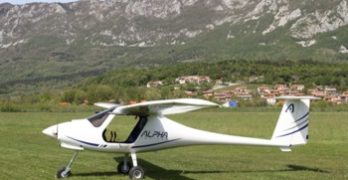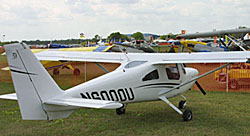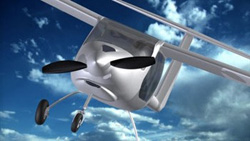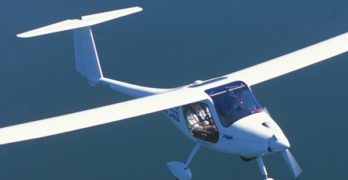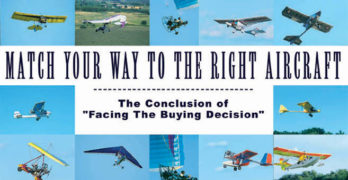Just a few short months ago I posted an announcement from Pipistrel about its upcoming, mid-$80K ALPHA Trainer, targeted for flight schools and already bought in significant quantities by the Indian Air Force as a military primary trainer. *** ALPHA was promised for April, and Pipistrel nailed it – how often do we see that in manufacturing?Pipistrel is the same progressive Slovenian company that won the CAFE electric flight competition last year with the Taurus Electro G4 and has gained a growing reputation in the sport aviation industry for innovative, high-performing, highly efficient aircraft such as the Virus and Sinus S-LSA.After keeping its promise to debut the ALPHA in April at the European AERO show, word comes from Ivo Boscarol and company of the successful conclusion of flight testing. The ALPHA is now in production. *** The original concept was to create a do-it-all trainer that would garner substantial orders, enabling mass production economies of scale that would keep costs affordable for everyone.
Search Results for : Alpha Electro
Not finding exactly what you expected? Try our advanced search option.
Select a manufacturer to go straight to all our content about that manufacturer.
Select an aircraft model to go straight to all our content about that model.
LSA Highlights from Sun ‘n Fun 2012
Whew! It’s over. Man, Sun ‘n Fun can be the busiest six days of one’s life… well, at least until the next one. In this survey article, I want to skim the very top of what I found interesting at the recently concluded show. Each highlight will get fuller coverage. Before starting, though, I owe a couple shout-outs. *** A huge, enormous thanks to Jim Lawrence who kept you up on a daily basis. Accomplishing that means long days shooting photos, interviewing personalities, and working into the night in a motel room with a crappy Internet connection. It may look easy and fun but only half that assessment is true (hint: it ain’t easy). *** Secondly, another thanks-a-million to UltralightNews, my video collaborator. I have the easy job; they will put in an enormous number of hours to edit and finish more than two dozen new videos that I’ll post here as each is done.
Knocking Around The InfoVerse
|||| News travels fast these days: Just ask Herman Cain. New tech net scraper Gizmag just ran a blurb on the Pipistrel Alpha that I covered earlier. Gizmag’s focus is on Alpha’s low cost, which as they note is less than €60,000 (currently about $80,000). *** Now consider this: if the euro continues to go through its troubles and drops further against the dollar, imagine a quality SLSA, like the Alpha promises to be (it’s based on a years-proven design — the Vinus/Sinus — with hundreds now delivered), priced at, perhaps, $70,000. For all of us who’ve decried the high costs of LSA, might this be the price point/airplane that would help break the LSA sales logjam? |||| Dynon plans Hands-On SkyView Training at Sebring. Who among us hasn’t sat for the first time in a new LSA and felt brain overload when confronted with an unfamiliar EFIS display?
Sleek, Comfortable and Fun; The Sinus Motorglider
Many Americans will agree
the name of this aircraft is odd, and that may be a kind word for the common reaction to “Sinus.” Is the name that important? Sinus (pronounced Seen-us), the aircraft, is a sleek, slender machine capable of impressive performance.
Any soaring-attuned pilot can easily live with the name Sinus for the 49-foot span and, get this, 28-to-1 glide performance! On first glance, except for its elegant, shapely, and thin wings, the Sinus looks like a proper light sport airplane. Pilot Matevz Lenarcic flew one around the world solo, in 80 days, and with zero ground or air support (see “Microlight Motorglider Flies Around the World,” April ’05 UltralightFlying! magazine).
What’s In a Name After All?
Let’s consider that name. U.S. dealer Robert Mudd says Pipistrel – the manufacturer – prefers to pronounce it “seen-us,” not “sighn-us.” They say this refers to a perfect sound wave or sine wave rather than a head cold.
How-to-Buy a Lightplane — Part 3 of 3
In the previous two installments, we’ve discussed you, the pilot, and the many types of aircraft choices you have. As we wrap up this series, we’ll put it all together and try to help you narrow your choices to a few models.
Notice the word “try.” It is important that you understand that it is not possible to direct you to the one-and-only best choice of aircraft. Novice buyers often seek assistance but even experienced pilots can become swayed and end up purchasing the wrong aircraft for their needs and desires. Because aircraft purchases are commonly emotional decisions, it is helpful to gain a “second opinion” to help make a more rational choice.
Many years ago, at the beginning of my career writing articles in light aviation, I made a similar attempt to help hang glider pilots choose the right glider. I compared nine contemporary models to an idealized “perfect” glider and through a series of questions much like those below, tried to steer pilots to the one right glider for them.
Product Lines – January 00
ST. PAUL, MINN., — Welcome to a new era of hang gliding… well, and everything else, I guess. If you’re reading this, the Y2K bug evidently didn’t stop civilization as some feared. At least you got your Hang Gliding magazine. Is something more important than that? ••• As we start a new millennia, it pays to take stock of the state of the art. Topless flexwings are achieving great flights and cost Six Grand. Rigids wings seem to be the new darlings despite breaking the Ten Grand price barrier. We have carbon/kevlar helmets, highly sophisticated electronic navigation and flight performance instruments, and everybody flies with a parachute, sometimes two. Heck, we’ve even got luxury sport utility vehicles to haul it all around. Aren’t we something, cool 21st Century pilots? So I suppose it makes sense that lots of attention seems focused on the harness as we start a new year. It’s the new front line in the relentless drive for more performance.


